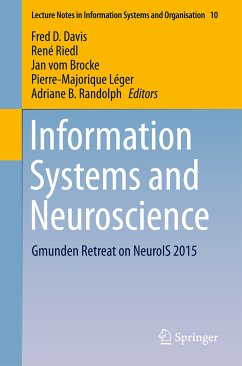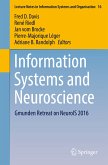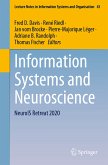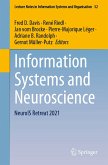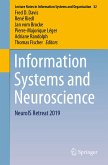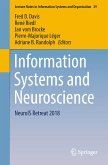Information Systems and Neuroscience (eBook, PDF)
Gmunden Retreat on NeuroIS 2015
Redaktion: Davis, Fred D.; Randolph, Adriane B.; Léger, Pierre-Majorique; Vom Brocke, Jan; Riedl, René
40,95 €
40,95 €
inkl. MwSt.
Sofort per Download lieferbar

20 °P sammeln
40,95 €
Als Download kaufen

40,95 €
inkl. MwSt.
Sofort per Download lieferbar

20 °P sammeln
Jetzt verschenken
Alle Infos zum eBook verschenken
40,95 €
inkl. MwSt.
Sofort per Download lieferbar
Alle Infos zum eBook verschenken

20 °P sammeln
Information Systems and Neuroscience (eBook, PDF)
Gmunden Retreat on NeuroIS 2015
Redaktion: Davis, Fred D.; Randolph, Adriane B.; Léger, Pierre-Majorique; Vom Brocke, Jan; Riedl, René
- Format: PDF
- Merkliste
- Auf die Merkliste
- Bewerten Bewerten
- Teilen
- Produkt teilen
- Produkterinnerung
- Produkterinnerung

Bitte loggen Sie sich zunächst in Ihr Kundenkonto ein oder registrieren Sie sich bei
bücher.de, um das eBook-Abo tolino select nutzen zu können.
Hier können Sie sich einloggen
Hier können Sie sich einloggen
Sie sind bereits eingeloggt. Klicken Sie auf 2. tolino select Abo, um fortzufahren.

Bitte loggen Sie sich zunächst in Ihr Kundenkonto ein oder registrieren Sie sich bei bücher.de, um das eBook-Abo tolino select nutzen zu können.
This book presents the proceedings of the Gmunden Retreat on NeuroIS 2015, reporting on topics at the intersection of Information Systems (IS) research, neurophysiology and the brain sciences. Readers will discover the latest findings from top scholars in the field of NeuroIS, which offer detailed insights on the neurobiology underlying IS behavior, essential methods and tools and their applications for IS, as well as the application of neuroscience and neurophysiological theories to advance IS theory.
- Geräte: PC
- ohne Kopierschutz
- eBook Hilfe
- Größe: 4.2MB
Andere Kunden interessierten sich auch für
![Information Systems and Neuroscience (eBook, PDF) Information Systems and Neuroscience (eBook, PDF)]() Information Systems and Neuroscience (eBook, PDF)73,95 €
Information Systems and Neuroscience (eBook, PDF)73,95 €![Information Systems and Neuroscience (eBook, PDF) Information Systems and Neuroscience (eBook, PDF)]() Information Systems and Neuroscience (eBook, PDF)73,95 €
Information Systems and Neuroscience (eBook, PDF)73,95 €![Information Systems and Neuroscience (eBook, PDF) Information Systems and Neuroscience (eBook, PDF)]() Information Systems and Neuroscience (eBook, PDF)73,95 €
Information Systems and Neuroscience (eBook, PDF)73,95 €![Information Systems and Neuroscience (eBook, PDF) Information Systems and Neuroscience (eBook, PDF)]() Information Systems and Neuroscience (eBook, PDF)105,95 €
Information Systems and Neuroscience (eBook, PDF)105,95 €![Information Systems and Neuroscience (eBook, PDF) Information Systems and Neuroscience (eBook, PDF)]() Information Systems and Neuroscience (eBook, PDF)73,95 €
Information Systems and Neuroscience (eBook, PDF)73,95 €![Information Systems and Neuroscience (eBook, PDF) Information Systems and Neuroscience (eBook, PDF)]() Information Systems and Neuroscience (eBook, PDF)73,95 €
Information Systems and Neuroscience (eBook, PDF)73,95 €![Information Systems and Neuroscience (eBook, PDF) Information Systems and Neuroscience (eBook, PDF)]() Information Systems and Neuroscience (eBook, PDF)121,95 €
Information Systems and Neuroscience (eBook, PDF)121,95 €-
-
- -31%11
This book presents the proceedings of the Gmunden Retreat on NeuroIS 2015, reporting on topics at the intersection of Information Systems (IS) research, neurophysiology and the brain sciences. Readers will discover the latest findings from top scholars in the field of NeuroIS, which offer detailed insights on the neurobiology underlying IS behavior, essential methods and tools and their applications for IS, as well as the application of neuroscience and neurophysiological theories to advance IS theory.
Dieser Download kann aus rechtlichen Gründen nur mit Rechnungsadresse in A, B, BG, CY, CZ, D, DK, EW, E, FIN, F, GR, HR, H, IRL, I, LT, L, LR, M, NL, PL, P, R, S, SLO, SK ausgeliefert werden.
Produktdetails
- Produktdetails
- Verlag: Springer International Publishing
- Seitenzahl: 219
- Erscheinungstermin: 28. Mai 2015
- Englisch
- ISBN-13: 9783319187020
- Artikelnr.: 43783520
- Verlag: Springer International Publishing
- Seitenzahl: 219
- Erscheinungstermin: 28. Mai 2015
- Englisch
- ISBN-13: 9783319187020
- Artikelnr.: 43783520
- Herstellerkennzeichnung Die Herstellerinformationen sind derzeit nicht verfügbar.
René Riedl ist Universitätsassistent am Institut für Wirtschaftsinformatik - Information Engineering der Johannes Kepler Universität Linz sowie wissenschaftlicher Mitarbeiter am Institut für Personal- und Organisationsentwicklung in Wirtschaft und Verwaltung an der Johannes Kepler Universität Linz.
NeuroIS Knowledge Discovery Approach to Prediction of Traumati Brain Injury Survival Rates: A Semantic Data Analysis Regression Feasibility Study.- The Status Quo of Neurophysiology in Organizational Technostress Research: A Review of Studies Published from 1978 to 2015.- The Impact of Interruptions on Technology Usage: Exploring Interdependencies between Demands from Interruptions, Worker Control, and Role-based Stress.- An Investigation of the Nature of Information Systems from a Neurobiological Perspective.- A Hot Topic - Group Affect Live Biofeedback for Participation Platforms.- (Online)-buying Behavior and Personality Traits: Evolutionary Psychology and Neuroscience based.- Choice of a NeuroIS Tool: An AHP-based Approach.- Foreign Live Biofeedback: Using others' neurophysiological data.- What does the skin tell us about information systems usage? A literature-based analysis of the utilization of electrodermal measurement for IS Research.- A Novel, Low-cost NeuroIS Prototype for Supporting Bio Signals Experimentation Based on BITalino.- The evaluation of different EEG sensor Technologies.- Choice Architecture: Using Fixation Patterns to Analyze the Effects of Form Design on Cognitive Biases.- Neurophysiological Analysis of Visual Syntax in Design.- The Influence of Cognitive Abilities and Cognitive Load on Business Process Models and their Creation.- An Evolutionary Explanation of Graph Comprehension using fMRI.- Investigation of the relationship between visual website complexity and users' mental workload: A NeuroIS perspective.- Measuring Cognitive Load During Process Model Creation.- Cognitive Differences and their Impact on Information Perception: An Empirical Study Combining Survey and Eye Tracking Data.- Using fMRI to Explain the Effect of Dual-Task Interference on Security Behavior.- Measuring Appeal in Human Computer Interaction: A Cognitive Neuroscience-Based Approach.- Mobile App Preferences: What Role Does Aesthetics and Emotions Play?.-Identifying Neurological Patterns Associated with Information Seeking: A Pilot fMRI Study.- Proposal for the Use of a Passive BCI to Develop a Neurophysiological Inference Model of IS Constructs.- Emotion is not what you think it is: Startle Reflex Modulation (SRM) as a measure of affective processing in NeuroIS.- Measuring flow using psychophysiological data in a multiplayer gaming context.- Using A Cognitive Analysis Grid to Inform Information Systems Design.- Research directions for methodological improvement of the statistical analysis of electroencephalography data collected in NeuroIS.- Measuring visual complexity using: neurophysiological data.- Using NeuroIS to Better Understand Activities Performed on Mobile Devices.
NeuroIS Knowledge Discovery Approach to Prediction of Traumati Brain Injury Survival Rates: A Semantic Data Analysis Regression Feasibility Study.- The Status Quo of Neurophysiology in Organizational Technostress Research: A Review of Studies Published from 1978 to 2015.- The Impact of Interruptions on Technology Usage: Exploring Interdependencies between Demands from Interruptions, Worker Control, and Role-based Stress.- An Investigation of the Nature of Information Systems from a Neurobiological Perspective.- A Hot Topic - Group Affect Live Biofeedback for Participation Platforms.- (Online)-buying Behavior and Personality Traits: Evolutionary Psychology and Neuroscience based.- Choice of a NeuroIS Tool: An AHP-based Approach.- Foreign Live Biofeedback: Using others' neurophysiological data.- What does the skin tell us about information systems usage? A literature-based analysis of the utilization of electrodermal measurement for IS Research.- A Novel, Low-cost NeuroIS Prototype for Supporting Bio Signals Experimentation Based on BITalino.- The evaluation of different EEG sensor Technologies.- Choice Architecture: Using Fixation Patterns to Analyze the Effects of Form Design on Cognitive Biases.- Neurophysiological Analysis of Visual Syntax in Design.- The Influence of Cognitive Abilities and Cognitive Load on Business Process Models and their Creation.- An Evolutionary Explanation of Graph Comprehension using fMRI.- Investigation of the relationship between visual website complexity and users' mental workload: A NeuroIS perspective.- Measuring Cognitive Load During Process Model Creation.- Cognitive Differences and their Impact on Information Perception: An Empirical Study Combining Survey and Eye Tracking Data.- Using fMRI to Explain the Effect of Dual-Task Interference on Security Behavior.- Measuring Appeal in Human Computer Interaction: A Cognitive Neuroscience-Based Approach.- Mobile App Preferences: What Role Does Aesthetics and Emotions Play?.-Identifying Neurological Patterns Associated with Information Seeking: A Pilot fMRI Study.- Proposal for the Use of a Passive BCI to Develop a Neurophysiological Inference Model of IS Constructs.- Emotion is not what you think it is: Startle Reflex Modulation (SRM) as a measure of affective processing in NeuroIS.- Measuring flow using psychophysiological data in a multiplayer gaming context.- Using A Cognitive Analysis Grid to Inform Information Systems Design.- Research directions for methodological improvement of the statistical analysis of electroencephalography data collected in NeuroIS.- Measuring visual complexity using: neurophysiological data.- Using NeuroIS to Better Understand Activities Performed on Mobile Devices.
